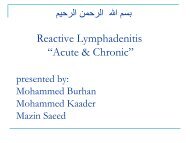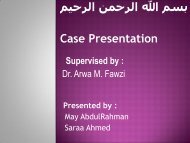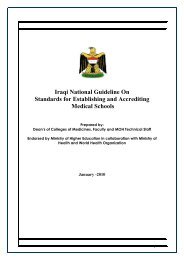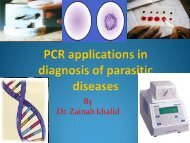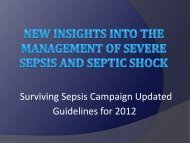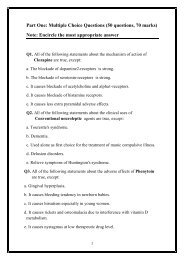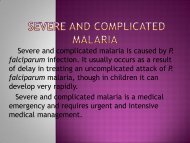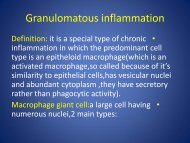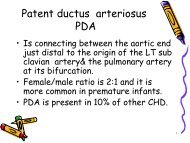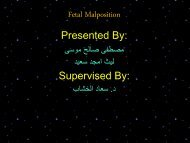Volume 35 June 2009 Number 1 - University of Mosul
Volume 35 June 2009 Number 1 - University of Mosul
Volume 35 June 2009 Number 1 - University of Mosul
You also want an ePaper? Increase the reach of your titles
YUMPU automatically turns print PDFs into web optimized ePapers that Google loves.
Annals <strong>of</strong> the College <strong>of</strong> Medicine Vol. <strong>35</strong> No. 1, <strong>2009</strong><br />
الاستنتاج: يمكن استخدام التهاب بطانة الشريان ألانسدادي لأوعية الغشاء الساقط مع التغيرات المظهرية الأخرى آمؤشر<br />
لحدوث الحمل في حالة عدم وجود الزغابات المشيمية، الطبقة الغاذية والعناصر الجنينية الأخرى.<br />
T<br />
he histopathological diagnosis <strong>of</strong> a<br />
pregnancy is usually dependent upon<br />
finding <strong>of</strong> fetal parts, gestational sac, viable or<br />
necrotic chorionic villi or trophoblast (1,2) .<br />
During implantation the trophoblast invades<br />
into capillaries and veins within the superficial<br />
endometrium and aggregates <strong>of</strong><br />
cytotrophoblast cells occlude the distal<br />
segments <strong>of</strong> the spiral arteries until a direct<br />
utero-placental circulation is established at<br />
around ninth to tenth weeks <strong>of</strong> gestation as a<br />
result <strong>of</strong> loosening <strong>of</strong> some <strong>of</strong> these arterial<br />
plugs (3, 4, 5, 6) .<br />
In the absence <strong>of</strong> fetal parts, trophoblast or<br />
chorionic villi, the presence <strong>of</strong> dilated vascular<br />
channels <strong>of</strong> placental beds are features helpful<br />
in distinguishing the true decidua <strong>of</strong><br />
intrauterine pregnancy from the deciduoid<br />
changes secondary to hormonal therapy (1,2) .<br />
Furthermore, the presence <strong>of</strong> enlarged<br />
hyalinized spiral arterioles and a fibrinoid<br />
matrix are also features suggestive <strong>of</strong><br />
intrauterine pregnancy (1) .<br />
The morphological changes observed in the<br />
spiral arteries during early pregnancy are not<br />
fully understood (7) . Obliterative changes<br />
involving one or more <strong>of</strong> the decidual spiral<br />
arteries have been well described in<br />
endometrial curettage biopsies (8) and were<br />
attributed in part to the interaction <strong>of</strong> the<br />
trophoblast with the arterial wall during their<br />
migration into these vessels (7) .<br />
The Arias-Stella reaction is the histological<br />
glandular feature that was originally described<br />
with the presence <strong>of</strong> intrauterine pregnancy,<br />
(9,10,11)<br />
ectopic pregnancy as well as in<br />
association with administration <strong>of</strong> exogenous<br />
hormones (12) . It is marked by hypersecretory<br />
gland with large cells, abundant clear to<br />
eosinophilic cytoplasm and irregularly<br />
protruded nuclei which exhibit hyperchromasia<br />
and marked pleomorphism (12) .<br />
The present study is designed to describe<br />
the morphological changes in the decidual<br />
vessels among abortion specimens prior to<br />
twenty weeks' gestation and to compare these<br />
features with those observed in the<br />
endometrial biopsies <strong>of</strong> non-pregnant women<br />
as a control group and with Arias-Stella<br />
reaction as a possible marker <strong>of</strong> viable<br />
pregnancy.<br />
Patients and method<br />
Patients<br />
During the period <strong>of</strong> study between October<br />
2004 to <strong>June</strong> 2005, products <strong>of</strong> conception<br />
were collected from 161 reproductive aged<br />
women with different clinical types <strong>of</strong> abortion<br />
prior to 20 weeks' gestation. The age <strong>of</strong><br />
women varied from 17-45 years. They were<br />
admitted for uterine evacuation at both Al-<br />
Khansa and Al-Batool Teaching Hospitals in<br />
<strong>Mosul</strong> City. The occurrence <strong>of</strong> a pregnancy<br />
was confirmed by a pregnancy test and/ or<br />
ultrasonography. An obstetric history <strong>of</strong> preeclampsia,<br />
diabetes, and Rhesus<br />
incompatibility were excluded. The evacuation<br />
<strong>of</strong> the uterus was performed by either D & C<br />
or sponging curettage. Endometrial tissues<br />
were fixed in 10% neutral formalin, embedded<br />
in paraffin blocks, cut at 5µ sections and<br />
stained by H & E.<br />
Histopathological Examination<br />
On microscopical examination, obliterative<br />
endarteritis <strong>of</strong> decidual blood vessels were<br />
described and classified depending upon the<br />
severity <strong>of</strong> luminal narrowing and the degree <strong>of</strong><br />
intimal proliferation (8) , as follow:<br />
Grade 0: Normal arterioles.<br />
Grade I: Arterioles with slight thickening <strong>of</strong><br />
their walls and minimal intimal proliferation.<br />
Grade II: Arterioles with moderately severe<br />
wall thickening with a lumen –to-wall ratio 2:1<br />
or 1:1 or with eccentric intimal proliferation and<br />
intimal foamy cells.<br />
Grade III: At least one or more <strong>of</strong> the vessels<br />
is showing a near total obliteration <strong>of</strong> the<br />
lumen due to marked intimal hyperplasia and<br />
intimal foamy cells with surrounding edema.<br />
© <strong>2009</strong> <strong>Mosul</strong> College <strong>of</strong> Medicine 38






